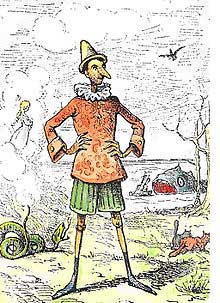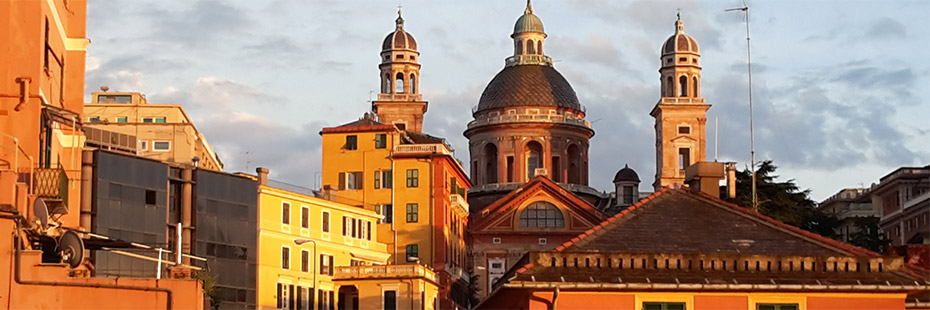With the CyberItalian method you learn the language activating all your senses, and you learn the culture through famous personalities of the Italian culture, industry, history and literature.
Every Self-Study lesson is divided into 5 steps:
![]() Listen and speak
Listen and speak
![]() Learn the Culture
Learn the Culture
![]() Discover the Grammar
Discover the Grammar
![]() Exercise
Exercise
![]() Have fun and reinforce
Have fun and reinforce
READ MORE
The CyberItalian Method is based on a program developed for the UNSRC Circolo Culturale Italiano at the United Nations in New York. READ MORE

In the Self-Study lessons, you meet Pinocchio, a wooden puppet from Italian literature who became famous all over the world, and you meet other famous people from the culture and history of Italy: from Leonardo (the Genius) to Michelangelo (the art Master), from Rossini (the Opera composer) to Machiavelli (the philosopher and politician) and many more. READ MORE

The CyberItalian Method gradually presents the beginner, intermediate, and advanced structures of the Italian language. READ MORE

Our method is also based on scientific researches as it includes:
- structures to understand how the language works
- educational activities that require body involvement (handwriting, cutting and sticking, gymnastics, cooking, singing...)
- critical thinking about human values and personal growth. READ MORE
DI SEGUITO IL TESTO ESTESO DI OGNI READ MORE:
With the CyberItalian method you learn the language activating all your senses, and you learn the culture through famous personalities of the Italian culture, industry, history and literature.
Every Self-Study lesson is divided into 5 steps
![]() Listen and speak
Listen and speak
![]() Learn the Culture
Learn the Culture
![]() Discover the Grammar
Discover the Grammar
![]() Exercise
Exercise
![]() Have fun and reinforce
Have fun and reinforce
READ MORE
![]() Listen and Speak (hear, "taste") = you are immediately exposed to the Italian language by listening to a dialogue, and by recording your voice. As you pronounce the Italian words, you feel the movement of your tongue and "taste" the new sounds, while you start acquiring the Italian language structures.
Listen and Speak (hear, "taste") = you are immediately exposed to the Italian language by listening to a dialogue, and by recording your voice. As you pronounce the Italian words, you feel the movement of your tongue and "taste" the new sounds, while you start acquiring the Italian language structures.
![]() Learn the Culture (hear, touch) = listen to the audio pronounced by professional actors and learn about Italian habits and culture, while you use your pen and paper to write and complete a cloze test.
Learn the Culture (hear, touch) = listen to the audio pronounced by professional actors and learn about Italian habits and culture, while you use your pen and paper to write and complete a cloze test.
![]() Discover the Grammar (see) = read and discover how the language and its structures work through grammatical explanations and charts.
Discover the Grammar (see) = read and discover how the language and its structures work through grammatical explanations and charts.
![]() Exercise (see) = read, practice and make the grammar alive as you put the language into use with exercises and exams. Acquire the language structures and verify the results in your progress report.
Exercise (see) = read, practice and make the grammar alive as you put the language into use with exercises and exams. Acquire the language structures and verify the results in your progress report.
![]() Have fun and Reinforce (smell, taste, hear, see, touch) = reinforce what you have learned, and practice with activities that involve all your senses. Some activities require you to cook (smell and taste), listen to songs and sing (hear), watch videos (see), read articles (see), listen to dialogues (hear), cut and glue paper and drawings (touch), write poems (touch, see), exercise (touch), complete a word-search (see), etc. FINE
Have fun and Reinforce (smell, taste, hear, see, touch) = reinforce what you have learned, and practice with activities that involve all your senses. Some activities require you to cook (smell and taste), listen to songs and sing (hear), watch videos (see), read articles (see), listen to dialogues (hear), cut and glue paper and drawings (touch), write poems (touch, see), exercise (touch), complete a word-search (see), etc. FINE
The CyberItalian Method is based on a program developed for the UNSRC Circolo Culturale Italiano at the United Nations in New York. READ MORE
The aim of our method is to provide students with the tools to both learn the language and learn how to learn it, so they quickly become independent in discovering the mechanisms of the language and deciding how to study and practice. Some students prefer a playful and communicative approach, others prefer a rational, analytical, or grammatical approach: our method includes all these aspects. FINE
In the Self-Study lessons, you meet Pinocchio, a wooden puppet from Italian literature who became famous all over the world, and you meet other famous people from the culture and history of Italy: from Leonardo (the Genius) to Michelangelo (the art Master), from Rossini (the Opera composer) to Machiavelli (the philosopher and politician) and many more. READ MORE
Pinocchio is more than a puppet: he is a restless spirit who represents the idea of 'personal growth' at all levels (including intellectual and emotional).
Personal growth and values are a very important factor in any positive learning process.
For this reason, during the beginner level you follow a modern Pinocchio (Pino for friends) as he discovers that his good friends, "il Gatto e la Volpe" (the Cat and the Fox), are not very good friends. But what is friendship after all?
In the Intermediate level Pino and his conscience "Grillo" (Jiminy Cricket), travel through Italy, meet very famous people and ask them what friendship is.
In the Advanced level Pino wants to grow-up and become rich and famous, even though he doesn't know what to do in life. But what is life after all?
FINE
The CyberItalian Method gradually presents the basic, intermediate, and advanced structures of the Italian language. READ MORE
In the Beginner level, you meet Pino and his friends, and you start to get involved with the Italian language and culture.
You learn how to greet someone, introduce your self or your family, express opinions, describe objects, places or situations, order at the restaurant, prepare a famous Italian dessert (Tiramisù), ask for directions, make a phone call, book a hotel room, go shopping, use the simple past, sing in Italian and much more!
In the Intermediate level you follow Pino while he travels through Italy, meets with very famous Italian people (Leonardo, Michelangelo, Rossini, etc.) and discusses cultural topics such as opera, art, literature.
You get to know more of Italian culture and you become familiar with Italian topics such as Opera, Art, Cinema and others. You learn how to express your opinions in a better way, understand more complex sentences, make comparisons, narrate a fact, write a letter, use the future and much more!
In the Advanced level, you follow Pino while he meets many renowned Italians (Dante, Ferrari, Galileo, etc.) and asks them how to find a job and become happy, rich and famous.
You get to know more and more of Italian culture through authentic material and you learn how to write your resume in Italian, make hypothesis, refine and maintain the language, use the subjunctive and much more! FINE
Our method is also based on scientific researches as it includes:
- structures to understand how the language works
- educational activities that require body involvement (handwriting, cutting and sticking, gymnastics, cooking, singing...)
- critical thinking about human values and personal growth.
. READ MORE
Scientific researches show How Humans Communicate Through Sound. This kind of studies led us to emphasize - throughout the entire course - the importance of listening to the sound of the Italian words and sentences in each lesson's Dialogue, repeating those sounds, getting immersed in the sound of the language in each Cultural Tidbit and cloze exercise, singing with specific Activities and finally becoming aware of the difference between listening to a recorded audio - that you can replay, slow down and hear many times - and a streaming audio or real time conversation - that you hear only one time. This practice trains the ear and improves listening and pronunciation skills.
Scientific researches show that handwriting helps memorization. This kind of studies led us to develop educational activities that require also body involvement: handwriting, cutting and glueing, gymnastics, cooking, singing.
Scientific researches show that understanding the structures of a foreign language helps learning and acquisition. This kind of studies led us to create the Dialogue area where students listen to the audios, read the transcripts and then analyze the sentence structures in the Grammar area.
Scientific researches show the Role of Personal Values in Learning Approaches and Student Achievements. This kind of studies led us to include in the course art and humanistic issues to stimulate reflections on personal life and values (e.g. "what is friendship after all?") and improve learning and acquisition.
Scientific researches show Specialized Memory Systems for Learning Spoken Words. This kind of studies have led us to create Exercises where students have to dictate or handwrite or type a word or sentence instead of just selecting the correct option.
Scientific researches show The Hebb repetition effect as a laboratory analogue of language acquisition. This kind of studies led us to create the Dialogue area where students listen to audios and record their voice, as many times as they want, and the Exercise pages where students can check the solution and rewrite the exercises as many times as they want.
TESTIMONIAL (more...):








